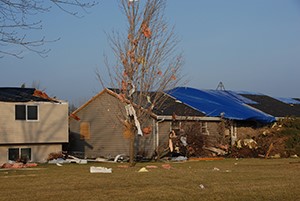Blue Roof Safety from OSHA

Reinforced plastic tarps, commonly called “Blue Roofs,” provide temporary protection for the roofs of houses and other buildings damaged during severe weather. When employees access these roofs to install these tarps, they are at risk for falls, electrocution, and other hazards. OSHA recommends the following steps to help keep workers safe.
Identify The Hazards
- Always avoid electricity: look for downed overhead power lines and treat all powers lines as “live.” Remember, generator use can cause “backfeed,” energizing lines that are no longer receiving power from the electrical grid.
- Contact the utility company to ensure lines are de-energized.
- Do not use a metal ladder near power lines or in close proximity to energized electrical equipment.
- Assess the roof condition and its stability: do not allow employees to work on top of a damaged roof until after the strength and structural integrity of the roof have been determined.
- Select the fall protection system(s) for the employees:
- For low-slope roofs, use conventional fall protection with or without a warning line system, a warning line system with a monitor, or a monitor alone on small roofs (50’ or less in width).
- For steep-slope roofs, workers should not stand on a steep roof without using a conventional fall protection system.
Installing The Tarp
- Never install a tarp during a storm while it’s windy or raining.
- Use proper personal protective equipment.
- Remove roof debris from ground level using a roof rake or brush.
- Whenever possible, avoid getting on the roof when tasks can be done from ladders or other stable platforms.
- When assessing the roof, lean the ladder at a safe angle that is at a 4:1 ratio, and make sure the ladder extends 3’ above the roof edge.
- Watch for trip hazards like vent stacks, satellite dishes, cables, and cleats.
- Do not walk on a tarp.
- Watch your step! Skylights and other openings that have been tarped over will not be obvious to someone walking on a roof.
For more information, check out osha.gov.


